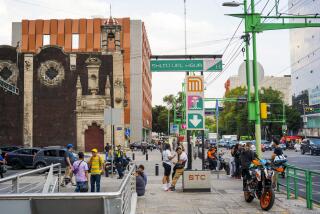An edgy quiet descends over Mexico City
- Share via
MEXICO CITY — Stroll around this city for long and a gnawing sensation grows. The children are missing. This is a place where, normally, children are noisy, abundant, doted upon.
In an instant, they seem to have disappeared.
The swine flu outbreak in Mexico City has achieved the seemingly impossible: It has stilled this clamorous megalopolis of 20 million people. The streets are suddenly emptier, safer to cross, but lonelier. The parks seem bigger without the children. Fear of infection and government restrictions on public gatherings have combined to produce something like a city in hiding.
A week after officials announced the outbreak of the H1N1 flu, Mexico City -- a teeming, polluted, noisy, thrilling behemoth -- feels more like Phoenix than it does the largest city in the Western Hemisphere.
The famously horrid traffic is suddenly manageable -- you can cross big boulevards such as the Paseo de la Reforma without sprinting in fear for your life. A “10-minute drive” has once again been transformed into --presto!-- a 10-minute drive.
The pace is not unlike that of a few other moments in the year when the bustling city slows down because so many capitalinos flee to the beaches: Christmas, Easter week.
This time, however, it is an edgy quiet, heavy with shared dread. Its emblem is the face mask, or tapaboca. One of the most jarring images in Mexico City this week is that of passengers staring silently from windows of passing city buses, their faces veiled below the eyes by the ubiquitous patches of blue or white.
That is hardly the only surreal aspect in a week that has, for many, conjured the mass uncertainty of the allegorical novel “Blindness” (though without the forced-confinement part).
Mexican officials closed the schools here a week ago, urging parents to keep their children inside and away from public places where the risk of infection is thought to be greater.
So far, parents are complying with surprising thoroughness, staying home with their children or shuttling them to their grandparents or friends for a (carefully considered) play date.
And, anyway, there is almost nowhere to go. Movie theaters are closed. So are museums.
Amid the crisis, playgrounds have been all but abandoned, providing a poignant tableau Thursday -- when the calendar called on Mexico to celebrate the annual Day of the Child.
Shopping centers, which normally draw well on Day of the Child, also reported sparse crowds.
One Mexican newspaper gave tips on how to celebrate the holiday at home. (A suggestion: Have the kids pretend to be doctors curing patients who are ill with -- we are not kidding -- influenza.)
The stillness doesn’t please everyone, of course. Many peddlers bemoan the sudden disappearance of customers. Along rows of restaurants, which have been barred from serving anything but takeout food, bored waiters fill the hours by repainting the furniture or staring at soccer games in dining rooms now dark and empty.
“It’s all because of this disease,” said Tomas Garcia Torres, glumly chewing a toothpick as he manned a near-deserted juice stand at the Chapultepec subway station. The subway is still running, but fewer people are riding. “No one is going out.”
An exception to the air of nervous quiet has been the supermarkets, which were overrun this week when rumors circulated that they were to be shut down.
That rumor turned out to be false, and President Felipe Calderon assured Mexicans that supermarkets would stay open, even as he urged “nonessential” businesses to take a breather during the long holiday weekend that begins today.
At one big-box retailer, crowds spilled out with carts heaped with food and other goods.
Among the favored items was one essential to weathering quarantine in the 21st century: the DVD player.
--
Cecilia Sanchez in The Times’ Mexico City Bureau contributed to this report.
More to Read
Sign up for Essential California
The most important California stories and recommendations in your inbox every morning.
You may occasionally receive promotional content from the Los Angeles Times.









